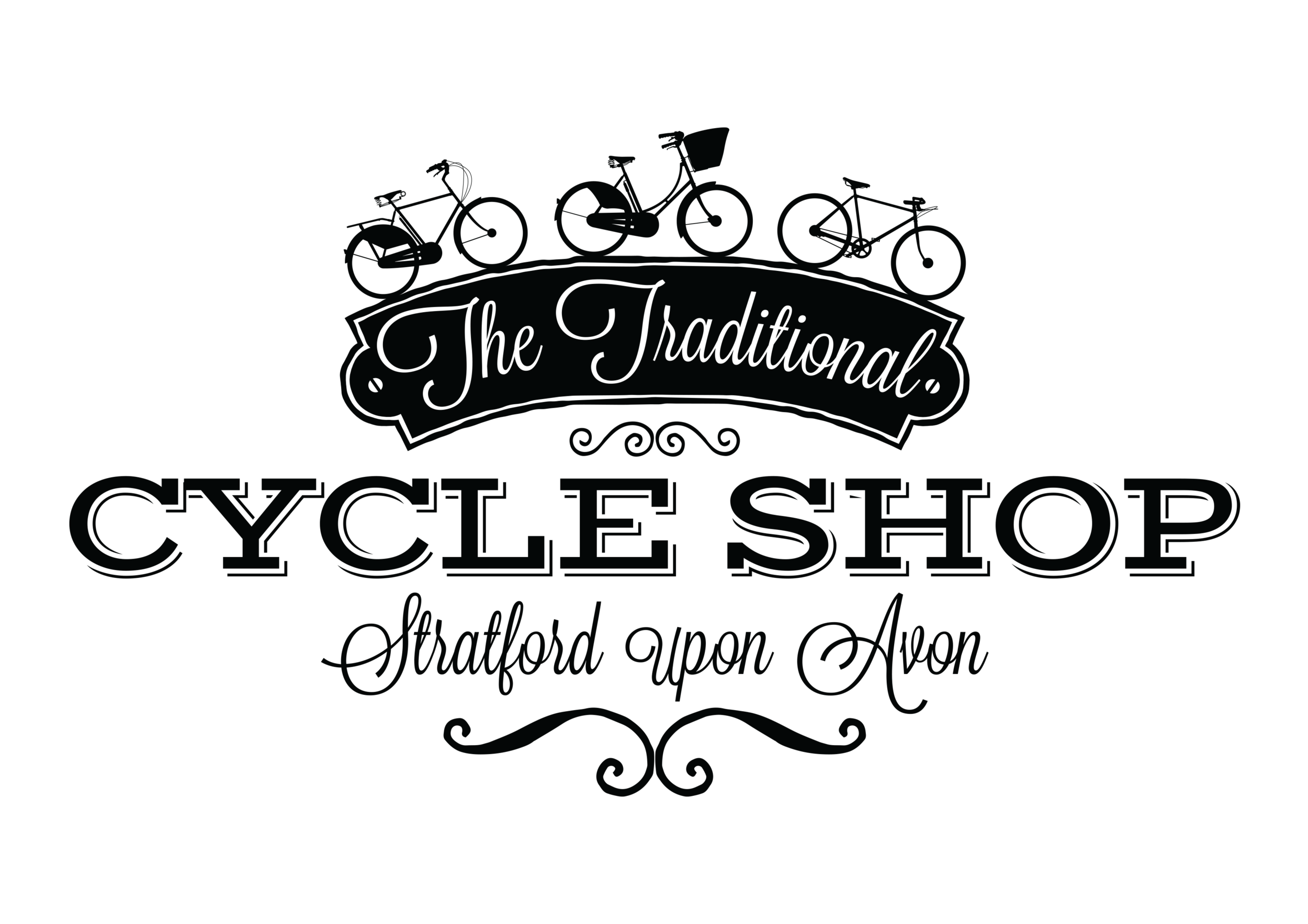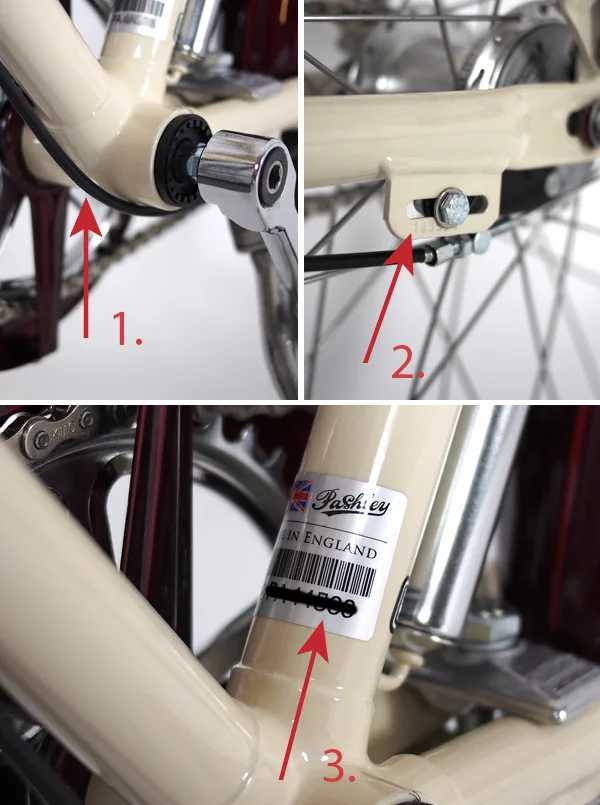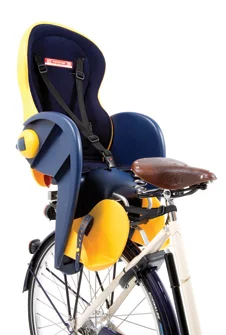Frequently Asked Questions
Pashley Cycles
Where are Pashley Cycles made?
Every Pashley cycle is hand-crafted in Britain, in the town of Stratford-upon-Avon (birthplace of William Shakespeare). Situated on the edge of the beautiful Cotswolds, Stratford has been home to Pashley since 1962; prior to this, from 1926, Pashley was based in Aston, near Birmingham. Pashley is England’s longest established manufacturer of hand-built bicycles, and is one of only three such companies in the UK.
How do I register my Pashley?
We recommend that all new cycles are registered with Pashley directly after purchase, to aid any future correspondence. Simply complete the registration card that you received with your cycle, and return it to Pashley by post. Alternatively, you can fill out our online registration form.
Where do I find my cycle’s frame and serial numbers?
1. Frame number - bottom bracket 2. Frame number - left chainstay 3. Serial number
Every Pashley cycle has its own unique frame and serial numbers. These numbers help to identify each bike, and should be noted down for insurance purposes. Both numbers appear on the guarantee card that you received with your cycle. They can also be found on the cycle frame: the frame number is either stamped into a plate that forms the mount for the rear hub-brake arm on the left chainstay (the non-drive side - see 2), or under the bottom bracket (where the peddle crank-shaft is held - see 1); the serial number can be found on the security label affixed low down on the seat tube (the security label also displays the barcode unique to your cycle, plus a Union Jack).
Can I use a child seat with my Pashley bicycle?
Offering safety-focused, Swiss-made quality designs, Pletscher is a leading producer of bicycle carrier systems. We are pleased to recommend the Pletscher child seat, which can be attached to any Pashley cycle that is fitted with a Pletscher rear ‘Athlete’ carrier rack. The Pletscher carrier rack comes fitted as standard to our Princess Sovereign and Sonnet Bliss bicycles, and is available as an option on the following models:
Britannia
Poppy
Penny
Parabike
Tuberider
Roadster 26
Pletscher Childseat
Pletscher carrier racks and child seats can be ordered through your local Pashley dealer, who will also be able to help you fit them. Please note: a Pletscher carrier cannot be fitted to the Roadster Classic or Sovereign 28” wheel models, so a Pletscher child seat cannot be used with these cycles.
What frame size do I need?
To select the correct frame size for your Pashley cycle, first measure your inside leg length (from the sole of your foot to the inner top of your thigh) in inches. Then, use the table below to find the frame size you will need. Frame sizes are shown in bold followed by the corresponding inside-leg length range.
Princess / Britannia/ Poppy - 17.5" = 27.5 - 31.5" 20" = 30 - 34" 22" = 32 - 36"
Guv'nor - 20" = 27 - 31" 20.5" = 29 - 33.5" 22.5" = 31 - 35.5" 24.5" = 33 - 37.5"
Speed 5 / Speed 3 - 20.5" = 29 - 33.5" 22.5" = 31 - 35.5" 24.5" = 33 - 37.5"
Roadster - 20.5" = 30 - 34.5" 22.5" = 32 - 36.5" 24.5" = 34 - 38.5"
Roadster 26 - 20" = 27 - 31"
Roadfinder - 48cm = 28 - 31" 50cm = 29 - 32" 53cm = 30.5 - 33" 56cm = 31.5 - 34" 59cm = 32.5 - 35"
Pathfinder - 50cm = 29 - 32" 53cm = 30.5 - 33" 56cm = 31.5 - 34" 59cm = 32.5 - 35"
Clubman / Countryman - 20" = 27 - 32" 21.5" = 28.5 - 33.5" 23" = 30 - 35" 24.5" = 31.5 - 36.5"
Aurora - 18" = 27 - 31" 20" = 30 - 34" 22" = 33 - 37"
Parabike / Penny / Tube Rider - 19" = 28 - 34"
Picador / Tri-1 15" = 25.5 - 32.5" 17" = 27.5 - 35.5"
The frame size in inches is the distance between the centrepoint of the cycle's bottom bracket (where the pedal arm extends from) and the top of the frame's seat tube (where the seatpost enters the frame).
What is the maximum load a Pashley can take?
Due to variations in riding styles and cycle usage patterns, any stated bicycle weight limit is somewhat subjective. However, we are legally obliged to provide weight limits for our cycles; please find these in the table below:
Bicycle -
Princess/Britannia/Poppy - 110 kg Max Load (rider+luggage) in KG / 240 lbs Max Load (rider+luggage) in lbs
Roadster/Roadster 26 - 120 kg Max Load (rider+luggage) in KG / 265 lbs Max Load (rider+luggage) in lbs
Guv'nor/Speed 5/Speed 3 - 120 kg Max Load (rider+luggage) in KG / 265 lbs Max Load (rider+luggage) in lbs
Penny - 110 kg Max Load (rider+luggage) in KG / 240 lbs Max Load (rider+luggage) in lbs
Parabike/Tuberider - 120 kg Max Load (rider+luggage) in KG / 265 lbs Max Load (rider+luggage) in lbs
Aurora/Countryman/Clubman - 120 kg Max Load (rider+luggage) in KG / 265 lbs Max Load (rider+luggage) in lbs
Pathfinder/Roadfinder - 120 kg Max Load (rider+luggage) in KG / 265 lbs Max Load (rider+luggage) in lbs
Tricycle -
Picador - 110kg + 25kg luggage Max Load (rider+luggage) in KG / 220lb + 55lb luggage Max Load (rider+luggage) in lbs
Tri 1 - 110kg + 25kg luggage Max Load (rider+luggage) in KG / 220lb + 55lb luggage Max Load (rider+luggage) in lbs
Pashley Cycles are built to very high standards and as well as being elegant in their design, they are also extremely robust, and are rigorously stress tested. It is important to be aware that heavy riders and those who frequently carry heavy loads will place more stress on their bicycle and on its components; these riders should ensure that their bicycle is serviced at frequent intervals. Cyclists who have a good riding style and ‘ride light’ tend to place less stress on their bicycle frames and components; all cyclists are encouraged to learn these skills, not only to enhance bicycle durability and reliability, but also to improve efficiency. Ultimately, all cycles – regardless of the load they carry – should be checked and serviced regularly.
What do I do if I’ve lost my frame-lock key?
If you find that you have lost the key for your bicycle’s frame-fitted lock, a new one can be purchased through AXA key service. You will need to know your key number to order a replacement (we do not keep a record of these numbers for security reasons). The link below will take you directly to AXA’s key service website page: https://keyservice.axasecurity.com/en-GB
What warranty is there for my Pashley?
The Pashley warranty covers the following:
Frame for five years from the purchase date (excludes front and rear suspension parts, paintwork and brightwork).
Other parts for one year from the date of purchase (subject to correct inspection). This excludes normal wear and tear and any consequential damage thus caused.
Please ensure that you retain your receipt of purchase, as this will be required if any claim is made while your cycle is under guarantee. Please also note that the guarantee is non-transferable if the cycle is sold on.
What kind of maintenance does my Pashley need?
Ideally, the following checks should be carried out every month:
Clean and check condition of frame and forks.
Check tightness of all nuts and bolts.
Check adjustment of gears and brakes.
Check headset adjustment.
Check condition of tyres and replace if required.
Check wheel condition - truth, rim dents, loose or broken spokes.
Lubricate chain and tighten if required.
Check condition of brake, gear cables and levers. Lubricate cables as required.
Check pedal tightness to cranks, crank tightness to bottom bracket axle, and play in bottom bracket and pedal bearings.
Check tyre threads regularly for embedded debris. This will help to prevent punctures.
If you are unsure about performing these monthly checks, please seek advice from your local Pashley dealer. In addition to these regular checks, we recommend that your bicycle is serviced fully at least once a year.
Why choose a Pashley cycle?
Pashley bicycles and tricycles are manufactured by skilled craftsmen, who use traditional methods to create work of the highest standard. Our designs focus on comfort, strength and durability; it is not in our ethos to produce fragile frames or specify complex, delicate components unnecessarily. We also believe that cycles should be a pleasure to use, and practical enough to integrate smoothly with everyday life. A Pashley cycle allows its rider to sit up comfortably, enjoying the view while any bags or shopping are carried safely and easily. In addition, Pashley is committed to UK manufacture and all the benefits this brings to customers, suppliers and dealers, and to our own employees.
Why do Pashley make bicycle frames from steel?
Although steel is sometimes regarded as ‘old-fashioned’, it is actually an excellent material for building bicycle frames. High tensile steels have far greater ultimate strength and stiffness values than aluminium alloy or titanium alloy; in fact, some modern steels have higher strength-to-weight ratios than aluminium and titanium. Steel responds well in fatigue conditions, and is able to withstand the repeated stress typically placed on a bicycle frame much more effectively than aluminium. If scratched or subject to minor impacts, steel is also fairly ‘forgiving’, in contrast to highly notch-sensitive carbon-fibre materials, which are more likely to fail following minor damage. Used intelligently, steel can be used to build great frames for all cycling disciplines. Specifically, a steel cycle frame can impart a better ‘feel’ and ride comfort than its aluminium equivalent.
Why do Pashley use hub gears for many of their cycles?
Hub gears may seem unusual in a world dominated by derailleur gears, but it is actually a very efficient system with a number of unique benefits. Unlike derailleurs (where the gear sprockets are exposed), all the mechanisms of hub gears are enclosed in a weather-resistant alloy shell, ensuring consistent reliability in all conditions. This also means that the gearing is not affected by the mud and grime thrown up from the road, which in turn means less maintenance is required than with an external derailleur system that can get clogged up over time. In addition, one little-known benefit of hub gears is the ability to change gear without pedalling. For instance, you can change into a lower gear whilst sat at a red light, without worrying about damaging the gears or having your chain come off. Hub gears are therefore ideal for town and country riding, allowing you to tackle all manner of terrain.
If you have any further questions please contact us on 01789 290703 or info@traditionalcycleshop.co.uk


